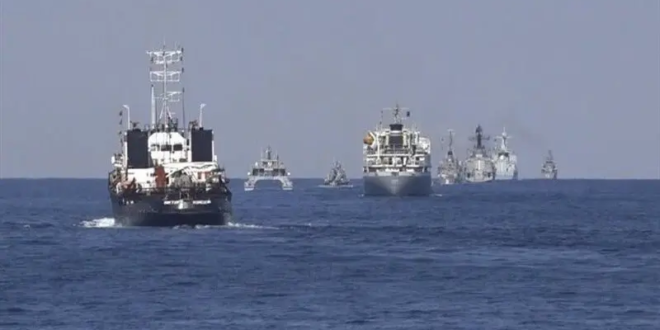Joint naval exercises among China, Russia, and Iran have significant implications for regional stability, power dynamics, and the existing world order. These exercises demonstrate a deepening of strategic mutual trust and cooperation between the three countries, as well as a potential challenge to the existing power dynamics and world order, particularly in regions such as the South China Sea and the Middle East.
China, Iran, and Russia recently held a joint naval drill in the Gulf of Oman, a crucial waterway near the mouth of the Persian Gulf. The drill, known as “Marine Security Belt 2024,” involved more than 20 ships, support vessels, and combat boats from the three countries, as well as naval helicopters. China sent the guided-missile destroyer Urumqi and the guided-missile frigate Linyi to the exercise, while Russia’s forces were led by the Varyag, a Slava-class cruiser.
The drill took place in 17,000 square kilometers (6,600 square miles) of water and was meant to improve trade, confront “piracy and terrorism, support humanitarian activities and the exchange of information in the field of rescue,” among other goals. Iran has stepped up its military cooperation with Beijing and Moscow in response to regional tensions with the United States, including due to supplying military drones to Russia now being used in Moscow’s war on Ukraine.
Azerbaijan, Kazakhstan, Oman, Pakistan, and South Africa were observers of the drill. The Gulf of Oman has seen a series of attacks since 2019 that the U.S. has blamed on Iran, as well as ship seizures by Tehran, since the collapse of its nuclear deal with world powers. A fifth of all oil traded passes through the Strait of Hormuz, the Persian Gulf’s narrow mouth.
The implications of these joint naval exercises are multifaceted and have far-reaching consequences for the involved nations, as well as the international community at large. They represent a deepening of strategic mutual trust and cooperation between the three countries, as evidenced by their enhanced collaboration in major security fields.
Furthermore, the participation of Iran in these exercises adds another layer of complexity to the implications, as it serves as a signal to the world that relations between Tehran, Moscow, and Beijing have reached a “meaningful” level.
The joint naval exercises attracted attention from other nations, particularly Japan, which has expressed concerns about the potential challenge they pose to the existing power dynamics and world order. Japan’s belief in the US-Japan Alliance as the source of security in East Asia is based on a Cold War mentality and regional security should be built on multilateral cooperation, rather than military alliances.
Strategic Implications and Regional Security
The joint naval exercises among China, Russia, and Iran have significant strategic implications and regional security concerns. These exercises have been taking place against the background of an unprecedented U.S. and Western naval presence in the Middle East, highlighting the rivalry between the China-Russia-Iran front and the Western powers in the region.
The Gulf of Oman, where the joint drills are taking place, is a crucial waterway near the mouth of the Persian Gulf and a significant conduit for global oil trade. The region has seen a series of attacks and ship seizures since 2019, which the U.S. has blamed on Iran, although Tehran has denied any involvement.
The joint drills served as a signal to the West that there is a counterstrategic military alliance between China, Russia, and Iran, and they aim to jointly maintain regional maritime security. The exercises are also intended to work out the safety of maritime economic activity, combat piracy and terrorism, support humanitarian activities, and create a maritime group in the future.
The participation of other nations, such as Pakistan, Kazakhstan, Azerbaijan, Oman, India, and South Africa, as observers further highlights the multilateral nature of these exercises and their potential to strengthen international cooperation in maintaining regional security. The joint drills also coincide with heightened tensions in the region due to the ongoing war in Gaza and Iran-backed Houthi rebels launching attacks on ships in the Red Sea.
The joint naval exercises among China, Russia, and Iran have significant implications for regional stability, power dynamics, and the existing world order. The strategic implications of joint naval exercises among China, Russia, and Iran are multifaceted and have far-reaching consequences for the involved nations and the international community.
Joint operations represent a deepening of strategic mutual trust and cooperation between the three countries, as well as a potential challenge to the existing power dynamics and world order. The statistics related to these exercises highlight the scale and scope of the joint drills and their goals, which include improving trade, combating piracy and terrorism, and supporting humanitarian activities.
 Eurasia Press & News
Eurasia Press & News




